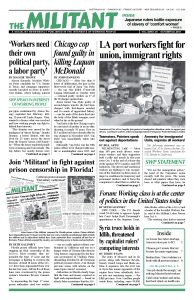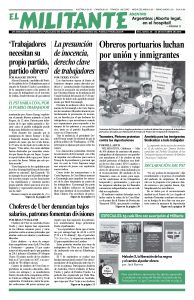The entry of Moscow and its air power, along with Tehran’s Revolutionary Guard troops and Shiite militias it organizes into the civil war in Syria has meant opponents of the regime have been relentlessly driven into one remaining region — the Idlib province. Over 3 million people reside there, including some 90,000 rebels forced to flee from other parts of the country.
When the reinforced Bashar al-Assad dictatorship announced its coalition forces would assault Idlib to crush its opponents, the Turkish regime, which supports the National Front for Liberation there, convinced Moscow to meet and discuss some kind of truce to prevent a bloody slaughter. They reached agreement last month to join in enforcing a “demilitarization” zone to separate Assad’s forces from those in Idlib, if a series of conditions and deadlines were met by Ankara, groups the Turkish rulers support, and some it doesn’t, including the former al-Qaeda Islamist group Hayat Tahrir al-Sham (HTS). October 15 is the deadline.
But the Turkish and Russian capitalist regimes have separate and clashing interests in Syria, working to expand their political, economic and military influence. And the same is true for Tehran.
The tentative pact put on hold Assad’s threatened assault. The groups aligned with Ankara have removed their tanks, artillery and other heavy weapons some 12 miles back from the front lines, creating the zone that the Turkish forces will patrol. But HTS has so far said nothing about what they will do and it is unclear whether they remain fully armed and in place.
With the government reasserting its sway over large parts of the country — except for the 25 percent of the country where the Kurdish-led Syrian Democratic Forces and its U.S. ally is based, and a small sliver on the Iraqi border where the Islamic State still has a foothold — there is nowhere else in Syria for those in Idlib to go.
The National Front for Liberation has demanded Ankara’s assurance that Moscow’s forces will not be permitted into the demilitarized zone, which was part of the original agreement between the Turkish and Russian rulers. The Turkish government said it would accede to the group’s demand, but so far Moscow hasn’t commented.
Additional Turkish troops and armament have deployed to the province to begin patrolling the zone. But they and their allies came under fire from the HTS Oct. 6. The Islamist forces also clashed with the Turkish-backed groups near the planned zone, taking control of two towns there.
Assad announced Oct. 7 that the regime considers this truce “temporary” and fully intends to retake the entire country.
Uprising against Assad regime
Working people across Syria rose up against the dictatorial regime in 2011. A civil war evolved as Assad’s repression crushed the courageous protests. Government forces were pushed out of widespread areas of the country. But with the vacuum of working-class leadership, reactionary Islamist groups and forces loyal to Turkey’s capitalist government came to the fore in many areas liberated from Assad’s rule.
Moscow and Tehran intervened in 2015 to drive back those rebelling against Assad’s rule and rescue his widely hated, anti-working-class regime. The Vladimir Putin regime in Russia did this to consolidate its military bases in Syria, wield greater influence in the region and strengthen its position against Washington. The capitalist regime in Iran intervened, seeking to expand its arc of counterrevolutionary political and military influence across Iraq and Syria to the Mediterranean. Tehran aims to more easily funnel weapons to its ally Hezbollah in Lebanon and to strengthen its position against rival rulers in Israel and Saudi Arabia.
This year the rulers in Tehran have faced popular protests against their wars abroad and the effects they have at home. Alongside their military intervention across the region, and attacks on the protests, the Iranian rulers have also ramped up assaults on Kurds in Iran. Some 30 million Kurds across Iran, Iraq, Syria and Turkey are denied a homeland by the rulers there and have fought for sovereignty and their national rights for decades.
Last month Kurdish shopkeepers in Iran led a strike to protest the execution of Kurdish prisoners and Tehran’s airstrikes on Iranian Kurds based in Iraq. In response, the Iranian Revolutionary Guard has deployed thousands of troops, special forces, tanks and heavy weaponry in a number of Kurdish cities in Iran. The Iranian Ministry of Intelligence has picked up and interrogated dozens of Kurds in recent weeks.
In the course of the Syrian civil war hundreds of thousands have been killed, mostly by the regime, and 12 million of the country’s 23 million people were driven from their homes, half of those seeking refuge in other countries. With entire cities in ruin and infrastructure devastated, few have returned.
Washington, along with the capitalist rulers in the EU, Saudi Arabia, Egypt and elsewhere in the Middle East, seek to limit Tehran’s advances. As part of this effort, the U.S. government has abrogated its nuclear agreement with Tehran and reapplied an expanding regime of sanctions. The U.S. rulers have also enforced sanctions on Syria for years, extending and tightening them after the 2011 uprising began. Like those Washington imposes on Iran, these sanctions fall hardest on the country’s toiling majority, making daily life an even harder struggle for survival.

